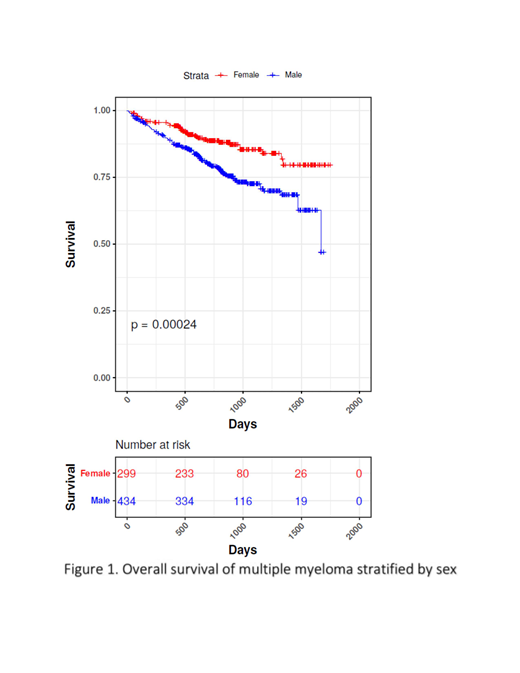Background
While survival of patients with multiple myeloma (MM) continues to improve, disparities in care are widely prevalent. While sex-based differences in cancer outcomes are apparent in several malignancies, these have not been studied as extensively in MM and consequently, the biology underlying these differences are unknown.
Methods
We utilized the Multiple Myeloma Research Foundation (MMRF) CoMMpass database (IA11) to evaluate the outcomes of MM by sex. The CoMMpass database includes over 1000 newly-diagnosed MM patients with enriched tumor samples analyzed using RNA sequencing (RNA-seq). Differentially expressed genes (DEGs) were predicted from RNA-seq data using the limma-voom method after TMM normalization, then gene set enrichment analyses using GSEA and WebGestalt and ClueGo were performed to assess for highly enriched pathways. We then performed multiple linear regression analysis using sex as the dependent variable. Other known high-risk prognostic markers were used as independent categorical or numeric variables. Categorical variables included age (</>65 years), beta2 microglobulin (>5.5 mg/L), elevated LDH (>ULN), presence of del 17p, t(4;14), t(14;16), gain chr 1q, del 1p and hyperdiploid status. Numeric variables included genes from the EMC-92 gene signature. Overall survival (OS) was estimated by Kaplan Meier method and log-rank test.
Results
Among patients with available data, females accounted for 44% (N=384) and males 56% (N=487) patients. Male sex is associated with inferior overall survival, with median survival (men 55 months vs women NR) (p=0.00024).
GSEA detected 310 out of 668 gene sets to be up-regulated in the female cohort of which 69 gene sets were significantly up-regulated (FDR q <25%). While in males, 358 out of the 668 gene sets queried were up-regulated and no gene set was significantly upregulated at FDR q<25%. Compared to males, significantly enriched gene sets in females were those involved oxidative metabolism (oxidative phosphorylation, respiratory electron transfer, and TCA cycle) which have been shown to be a function of B cell differentiation to support increased antibody production and may suggest a more differentiated plasma cell phenotype in women.
We then performed WebGestalt over-representation analysis (ORA) using up and down DEGs which showed that cell-cell junction, ECM proteoglycans, IFN gamma signaling, L1CAM interactions and axon guidance pathways were affected when comparing by sex.
Using the limma-voom method to predict DEGs (after TMM normalization), the up-regulated genes in women included those involved in protective processes such as inhibition of JAK/STAT mediated signaling (SOCS3), increased glutathione S transferase to detoxify products of oxidative stress (GSTM1), promotion of autophagy (DEPP1) as well as development of long term T cell immunity (TNFRSF4). Downregulated genes in women include those associated with increased proliferative potential such as cell-cell adhesion and signaling (LPHN2, EPHB1, LSAMP, NCAM1, CADM1, CD44, ANK3, CD99), cell cycle regulation (ZNF256, TEAD1, PDGFD), cytoskeletal proteins (MAP9, HYDIN, TMSB4X, TIAM1) and angiogenesis (PDE3B, VASH2).
Multiple linear regression analysis with sex as dependent variable showed no differences in the independent categorical variables tested between the male and female groups. 14 genes of the EMC-92 gene signature were also noted to significantly differ between the female and male groups (EHBP1L1, FGFR3, C1S, GRB14, HMGB3, ITM2B, LBR, MRPL41, RAB2A, RPS28, RPS4X, SPATS2L, TOP2A, TMEM97) along with genes expressed in multiple high-risk gene expression profiling signatures (TMEM97, ITM2B). These genes have been associated with cell survival, proliferation, differentiation and angiogenesis which may explain the differences in survival outcomes.
Conclusion
Female sex was associated with improved overall survival in the MMRF CoMMpass database. Over expression of several protective signatures and under expression of genes associated with increased proliferative signal may explain the differences in disease biology. Validation of these results in an independent cohort will help clarify these interesting and novel findings.
Girnius:Celgene: Membership on an entity's Board of Directors or advisory committees, Speakers Bureau; Takeda: Membership on an entity's Board of Directors or advisory committees, Speakers Bureau; Genentech: Membership on an entity's Board of Directors or advisory committees. Landau:Caelum: Membership on an entity's Board of Directors or advisory committees; Janssen: Honoraria, Membership on an entity's Board of Directors or advisory committees; Karyopharm: Consultancy, Honoraria; Celgene: Consultancy, Honoraria, Membership on an entity's Board of Directors or advisory committees; Amgen: Research Funding; Prothena: Membership on an entity's Board of Directors or advisory committees; Pfizer: Membership on an entity's Board of Directors or advisory committees; Takeda: Membership on an entity's Board of Directors or advisory committees, Research Funding. Costa:GSK: Consultancy, Honoraria, Research Funding; Abbvie: Consultancy; Karyopharm: Consultancy; Fujimoto Pharmaceutical Corporation Japan: Other: Advisor; Janssen: Research Funding, Speakers Bureau; Celgene: Consultancy, Honoraria, Research Funding; Amgen: Consultancy, Honoraria, Research Funding, Speakers Bureau; Sanofi: Consultancy, Honoraria, Speakers Bureau.
Author notes
Asterisk with author names denotes non-ASH members.


This feature is available to Subscribers Only
Sign In or Create an Account Close Modal